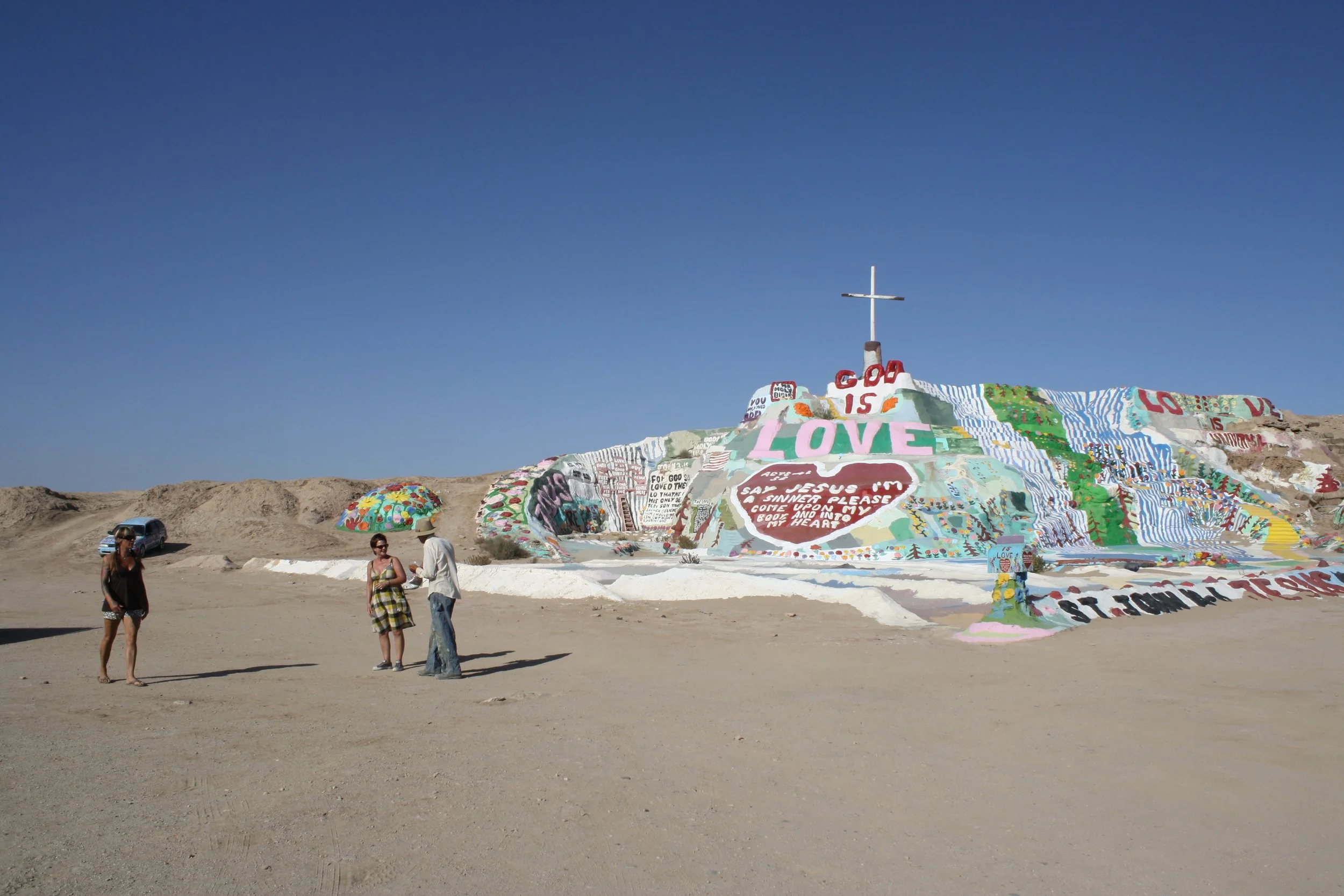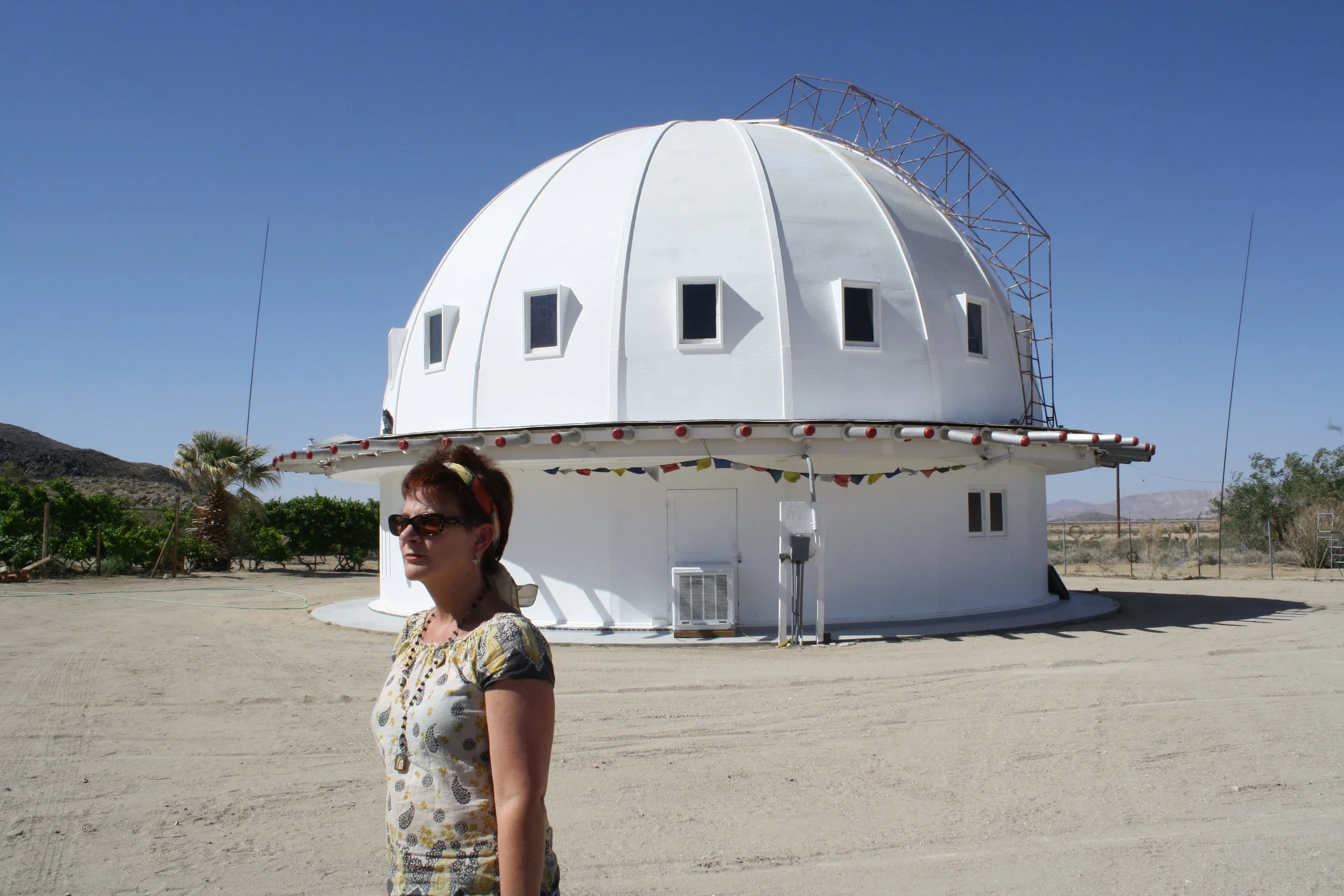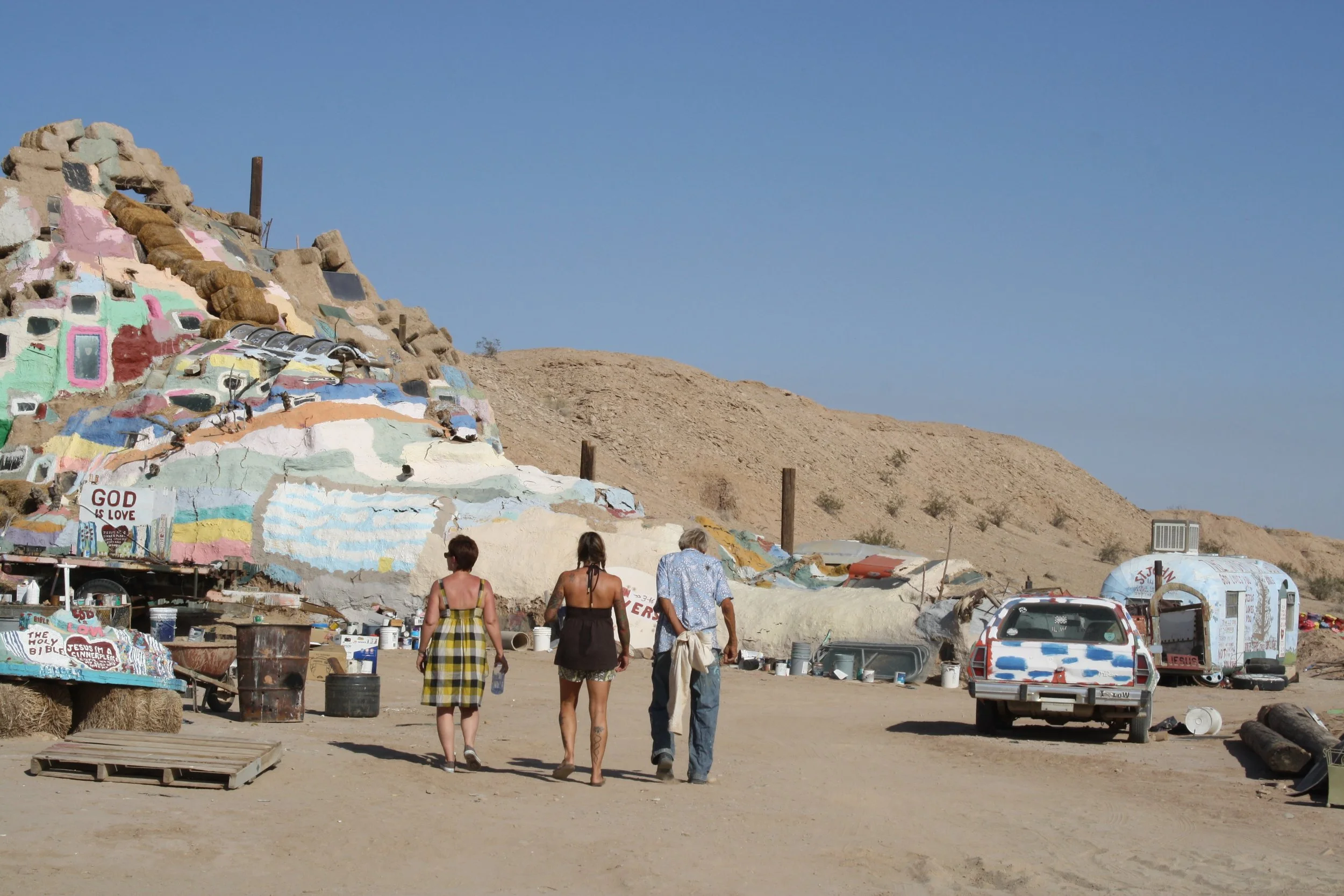His name was Leonard; I don’t know his last name. It’s probably on the Internet somewhere because a lot more people know a lot more about Leonard now than when I met him. I hadn’t expected to meet him there, although I don’t know where I thought he’d be. Home, I guess. I hadn’t considered that his home was Salvation Mountain, the three-story high straw-and-paint testament in the middle of the desert that proclaims, among other messages, “GOD IS LOVE.”
Lisa and Mom meeting Leonard for the first time in 2012.
When Leonard had originally arrived in Niland, California, he’d tried to spread his message of God’s love via hot air balloon. It didn’t have the impact he had hoped for, and, accepting defeat, he started to move on. At the town’s edge, Leonard decided to make one more attempt with his message, this time in a small monument. He piled dirt, concrete, and leftover paint that he found at the dump. He scrawled something about the love of the Lord on top of it all. Then he parked his car and then kept working on it for 28 years.
The first time I visited Salvation Mountain was in 2008. The mountain was wider than I had imagined and more thoroughly sun-faded. At its summit stood a white, wooden cross. On its south side was a maze of multi-colored caverns stitched together by spindly branches. There was a shrine room and an adobe hogan (a traditional Navajo structure) to provide cooler temperatures and shade during the summer. Still, Leonard chose to live out of his car.
We arrived in a borrowed, white Prius covered in Hawaiian flowers and Trader Joe’s logos. My mom and her friend Lisa both worked for Trader Joe’s at the time, and their store had sold the most turkeys that holiday season. The prize was a company Prius that employees could “check out” like a library book for one year. At the time, the Prius may as well have been a spaceship. Myself, my mom, and Lisa were unabashedly mesmerized by its wide, digital displays and impossible gas mileage. When it was our turn to drive it, we did the only reasonable thing we could think of: we drove it into the middle of the desert to look for aliens.
Mom, Lisa, and our little white Prius on loan.
We didn’t find any aliens, per se, but we stumbled upon extraterrestrial life in plenty. Naturally, we packed our trunk full of Trader Joe’s snacks. If we broke down in the middle of the California desert at least we’d have pretzel slims and pub cheese.
When we got to Salvation Mountain, we offered all of the food to Leonard. He refused everything except for a jug of water. I was baffled, the only food I’d seen for miles was a Mini Mart and a bar back in Niland (certainly no Trader Joe’s), and the man was as brittle looking as the straw he used to shape his monument. But Leonard was confident, quiet, and satiated by his faith in the Lord. Until that point, I had never seen such devotion.
I had friends that went to church. I knew which ones went to church specifically so that I could avoid sleeping over at their houses on Saturday nights. On the occasions that I did accidentally wake up at a devout friend’s house on a Sunday morning, my mom always suggested that I go to church with them. In fact, she encouraged both my brother and me to attend whenever we were invited. I guess she was just open-minded enough to think that maybe her kids would find something in it that she never had.
We never did. One time, after another altruistic family attempted to save our souls, my mom asked my brother and me, “How was church?” “I don’t yike that place,” my younger brother answered, “all they talk about is God.” She had apparently failed to explain what church was before agreeing to let him go. For all he knew he was off to play soccer and legos.
My mom was respectful, but she never went to a service herself. If there were any internal reasons to avoid church she never divulged them to us as kids, but she was vocal about the external reasons. I hesitate to say that she was a gay rights “activist” because I didn’t know her in the 80s—which would have been her prime time—but let’s just say that by the time I could walk she had me laced up in tiny Doc Martens, collecting money for different HIV/AIDS foundations. My mom was, what we’d call in today’s terms, an “ally.” In short, she couldn’t handle the hypocrisy of “loving thy neighbor” in concept but excluding entire groups of real people from that love.
Different denominations of faith offered good intentions, but my mom found shortcomings in all of them. And she didn’t just find them, she fixated on them. For that reason, religion in general remained a vague and distant term in my house.
Oddly, her aversion to religious institutions was balanced by an equally strong taste for religious art. It was her idea to visit Salvation Mountain that year—after stops at Sanchez’s Beer Bottle Chapel and Desert Christ Park. These were folk art monuments, over-the-top kitschy structures built with fewer resources than they needed and made glamorous by their insistence on holiness. They were eccentric. We never went looking for any architecturally profound basilicas or cathedrals, but we regularly pulled off the road for every single-owner, self-taught, DIY display of faith.
Mom in front of the Integratron, Niland, CA. Probably pondering the next snack.
As remote as these places were—in concept and in location—these folk-religious sites became our own sort of pilgrimage. But for us, it was about the people. Every artist we ever met, and many that we didn’t but whose art we enjoyed nonetheless, had a story that wound “from Amboy to Zzyzx,” as Joshua Tree-based radio host Ken Layne would say. These artists had a relentlessness about them. A devotion so deep that they didn’t need traditional methods or materials or even a consistent source of water. Their reverence inspired our own. Not of God, but of them.
Leonard was not the only one. Just down the road from Salvation Mountain is an abandoned army base called Slab City, referring to the slabs of concrete that army barracks once rested on. The residents of Slab City are mostly squatters or people who spent most of their time on the road before the road hit a dead end. A lot of them are also creative, also eccentric, and also devout. If you Google Slab City you’ll find landmarks like “The Blue Church,” “East Jesus,” and “Church of Enlightenment.” Each of them is a wily ode to the possibility of heaven and the certainty of earth.
It doesn’t seem like coincidence that these exhibits all stand in the wide California desert. This is the type of place where too much exposure to the elements — simply being there in the sun and heat— can have a hallucinatory effect. The desert is a place where paranoia and prophecy go hand in hand, where all kinds of “contact” has been made, where you can choose to believe all of it or none of it but “some of it” is not an option. Ken Layne put it best when he described the desert as a place where “even God is a possibility in a universe that is filled with such things.”
Mom and Lisa on the shore of the Salton Sea.
There are people in the desert—people like Leonard—to whom God seemed to be the only possibility. I’ve never known such devotion. And maybe it’s because I’m too afraid to be wrong. I think about Leonard the same way I think about a scientist or an engineer or an assembly line worker—so uniquely focused on one task that it seems almost impossible. And what if it turns out that he was wrong all along? What if, like Trey Parker suggests in the “Probably” episode of South Park, “it was…the Mormons. Yes, the Mormons was the correct answer.”
The thing is, we either know or we don’t and it doesn’t matter either way. I’ve derived my own view of faith from a repurposed Kendrick Lamar line which goes, “...what happens on earth stays on earth.” No matter where Leonard is now, he did something on earth that is akin to a miracle. He created a mountain in the desert using resources that were not locally available, surviving in the shade of a reclaimed military net, drinking only water, eating God knows what and God knows how often, full of his love for the Lord.
The second time I made the trip to Salvation Mountain was in 2015 to scatter my mom’s ashes. Leonard was dead by then, too. His car was still parked in front of the mountain. Under the military netting where he once sat with his water jugs at his feet — his “front porch,” you might call it — was a small donation box. Salvation Mountain, Inc. had taken over the property and the donations were spent on upkeep and “efforts of charity on Leonard’s behalf.”
Mom, Lisa, and Leonard in 2012.
When my mom died a lot of well-meaning people said things like, “She’s in a better place now.” And while I’d nod silently at them I’d think only, “No, she had it pretty good here, and now she’s gone.” She didn’t leave me with a reliance on faith or an unrealistic expectation that her spirit would be with me wherever I go. She did what she could while she was on Earth and that was more than enough. I do see her wherever I go, though. Not in a spiritual way, but in an earthly, aesthetic way. I see her in books, film, illustrations, and art—especially folk art.
My brother and I took some of her ashes to Salvation Mountain because it’s a work of folk art that embodied those earthly things she believed in — making do, spreading joy, endless love. Maybe she’s “up there somewhere” with Leonard, chilling with a jug of water under some army netting. I don’t dispute anyone who chooses to believe so. Personally, I choose to believe that she’s in the rolling ocean and the dusty deserts where we scattered her, in my favorite place on earth, on earth.
Published in Femme Salée (Sept. 2021: Eccentric Devotions).




